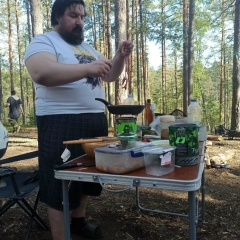Святая великомученица Варвара жила и пострадала при императоре Максимиане (305 - 311). Отец ее, язычник Диоскор, был богатым и знатным человеком в городе Илиополе Финикийском. Рано овдовев, он сосредоточил всю силу душевной привязанности на своей единственной дочери. Видя необыкновенную красоту Варвары, Диоскор решил воспитать се, скрывая от посторонних глаз. Для этого он построил башню, где, кроме Варвары, пребывали только ее языческие учителя. С башни открывался вид горнего и дольнего мира Божиего. Днем можно было смотреть на лесистые горы, на быстротекущие реки, на равнины, покрытые пестрым ковром цветов; ночью согласный и величавый хор светил являл зрелище невыразимой красоты. Вскоре девушка стала задавать себе вопрос о Причине и Создателе столь гармоничного и прекрасного мира. Постепенно она укрепилась в мысли, что бездушные идолы - творение рук человеческих, которым поклоняются ее отец и учителя, не могли столь мудро и великолепно устроить окружающий мир. Желание познать истинного Бога так захватило душу Варвары, что она решила посвятить этому жизнь и провести ее в девстве.
А слава о ее красоте распространилась в городе, и многие домогались ее руки, но она, несмотря на ласковые уговоры отца, отказывалась от брака. Варвара предупредила отца, что его настойчивость может окончиться трагически и разлучить их навсегда. Диоскор решил, что характер дочери изменился от замкнутой жизни. Он позволил ей выходить из башни и дал полную свободу в выборе друзей и знакомых. Девушка встретила в городе юных исповедниц веры Христовой, и они раскрыли ей учение о Творце мира, о Троице, о Божественном Логосе. Через некоторое время Промыслом Божиим в Илиополь приехал из Александрии под видом купца священник. Он совершил над Варварой таинство Крещения.
В то время при доме Диоскора строилась роскошная баня. По приказу хозяина рабочие готовились сделать в ней два окна на южную сторону. Но Варвара, пользуясь отсутствием отца, упросила их сделать третье окно, во образ Троичного Света. Над входом в купальню Варвара начертала крест, который прочно запечатлелся на камне. На каменных ступенях бани остался след ее ноги, из которого забил источник, явивший впоследствии великую целебную силу, которую Симеон Метафраст, описывая страдания святой мученицы, сравнивает с животворной силой струй Иордана и источника Силоамского. Когда Диоскор вернулся и выразил недовольство нарушением плана постройки, дочь рассказала ему о познанном ею Триедином Боге, о спасительной силе Сына Божия и о тщетности поклонения идолам. Диоскор пришел в ярость, обнажил меч и хотел поразить ее. Девушка побежала от отца, и он бросился за ней в погоню. Путь им преградила гора, которая расступилась и скрыла святую в расселине. С другой стороны расселины был выход наверх. Святой Варваре удалось скрыться в пещере на противоположном склоне горы. После долгих и безуспешных поисков дочери Диоскор увидел на горе двух пастухов. Один из них указал ему пещеру, где скрывалась святая. Диоскор жестоко избил дочь, а затем заключил ее под стражу и долго морил голодом. Наконец он предал ее правителю города Мартиану. Святую Варвару жестоко пытали: ее бичевали воловьими жилами, а раны растирали власяницей. Ночью в темнице святой деве, горячо молившейся своему Небесному Жениху, явился Сам Спаситель и уврачевал ее раны. Тогда святую подвергли новым, еще более жестоким пыткам.
Среди толпы, стоявшей близ места истязаний мученицы, находилась жительница Илиополя, христианка Иулиания. Сердце ее преисполнилось сочувствием к добровольному мученичеству красивой и знатной девушки. Иулиания также пожелала пострадать за Христа. Она начала громко обвинять мучителей. Ее схватили. Святых мучениц очень долго пытали: терзали крючьями тело, отрезали сосцы, обнаженными водили по городу с издевательствами и побоями. По молитвам святой Варвары Господь послал Ангела, который светозарной одеждой прикрыл наготу святых мучениц. Твердые исповедницы веры Христовой святые Варвара и Иулиания были обезглавлены. Святую Варвару казнил сам Диоскор. Возмездие Божие не замедлило постичь обоих мучителей. Мартиана и Диоскора: они были сожжены молнией.
В VI в. мощи святой великомученицы были перенесены в Константинополь. В XII в. дочь византийского императора Алексея Комнина (1081 - 1118), княжна Варвара, вступая в брак с русским князем Михаилом Изяславичем, перевезла их в Киев. В Киевском Владимирском соборе они покоятся и теперь.
А слава о ее красоте распространилась в городе, и многие домогались ее руки, но она, несмотря на ласковые уговоры отца, отказывалась от брака. Варвара предупредила отца, что его настойчивость может окончиться трагически и разлучить их навсегда. Диоскор решил, что характер дочери изменился от замкнутой жизни. Он позволил ей выходить из башни и дал полную свободу в выборе друзей и знакомых. Девушка встретила в городе юных исповедниц веры Христовой, и они раскрыли ей учение о Творце мира, о Троице, о Божественном Логосе. Через некоторое время Промыслом Божиим в Илиополь приехал из Александрии под видом купца священник. Он совершил над Варварой таинство Крещения.
В то время при доме Диоскора строилась роскошная баня. По приказу хозяина рабочие готовились сделать в ней два окна на южную сторону. Но Варвара, пользуясь отсутствием отца, упросила их сделать третье окно, во образ Троичного Света. Над входом в купальню Варвара начертала крест, который прочно запечатлелся на камне. На каменных ступенях бани остался след ее ноги, из которого забил источник, явивший впоследствии великую целебную силу, которую Симеон Метафраст, описывая страдания святой мученицы, сравнивает с животворной силой струй Иордана и источника Силоамского. Когда Диоскор вернулся и выразил недовольство нарушением плана постройки, дочь рассказала ему о познанном ею Триедином Боге, о спасительной силе Сына Божия и о тщетности поклонения идолам. Диоскор пришел в ярость, обнажил меч и хотел поразить ее. Девушка побежала от отца, и он бросился за ней в погоню. Путь им преградила гора, которая расступилась и скрыла святую в расселине. С другой стороны расселины был выход наверх. Святой Варваре удалось скрыться в пещере на противоположном склоне горы. После долгих и безуспешных поисков дочери Диоскор увидел на горе двух пастухов. Один из них указал ему пещеру, где скрывалась святая. Диоскор жестоко избил дочь, а затем заключил ее под стражу и долго морил голодом. Наконец он предал ее правителю города Мартиану. Святую Варвару жестоко пытали: ее бичевали воловьими жилами, а раны растирали власяницей. Ночью в темнице святой деве, горячо молившейся своему Небесному Жениху, явился Сам Спаситель и уврачевал ее раны. Тогда святую подвергли новым, еще более жестоким пыткам.
Среди толпы, стоявшей близ места истязаний мученицы, находилась жительница Илиополя, христианка Иулиания. Сердце ее преисполнилось сочувствием к добровольному мученичеству красивой и знатной девушки. Иулиания также пожелала пострадать за Христа. Она начала громко обвинять мучителей. Ее схватили. Святых мучениц очень долго пытали: терзали крючьями тело, отрезали сосцы, обнаженными водили по городу с издевательствами и побоями. По молитвам святой Варвары Господь послал Ангела, который светозарной одеждой прикрыл наготу святых мучениц. Твердые исповедницы веры Христовой святые Варвара и Иулиания были обезглавлены. Святую Варвару казнил сам Диоскор. Возмездие Божие не замедлило постичь обоих мучителей. Мартиана и Диоскора: они были сожжены молнией.
В VI в. мощи святой великомученицы были перенесены в Константинополь. В XII в. дочь византийского императора Алексея Комнина (1081 - 1118), княжна Варвара, вступая в брак с русским князем Михаилом Изяславичем, перевезла их в Киев. В Киевском Владимирском соборе они покоятся и теперь.
The Holy Great Martyr Barbara lived and suffered under the emperor Maximian (305 - 311). Her father, the pagan Dioscoros, was a rich and noble man in the city of Iliopolis of Phoenician. Widowed early, he concentrated all the strength of emotional attachment on his only daughter. Seeing the extraordinary beauty of Barbara, Dioskor decided to raise her, hiding from prying eyes. To do this, he built a tower where, except for Barbara, only its pagan teachers stayed. From the tower a view of the high and deep peace of God was revealed. During the day one could look at the wooded mountains, at the fast-flowing rivers, at the plains covered with a colorful carpet of flowers; at night, a consonant and stately choir of luminaries was a spectacle of inexpressible beauty. Soon, the girl began to ask herself a question about the Cause and Creator of such a harmonious and beautiful world. Gradually, she became convinced that soulless idols - the work of human hands, which her father and teachers worship, could not so wisely and splendidly arrange the world around her. The desire to know the true God so captivated the soul of Barbara that she decided to devote her life to it and spend it in virginity.
And the fame of her beauty spread in the city, and many molested her hands, but she, despite the tender persuasion of her father, refused to marry. Barbara warned her father that his perseverance could end tragically and tear them apart forever. Dioskor decided that the nature of his daughter changed from a secluded life. He allowed her to leave the tower and gave complete freedom in the choice of friends and acquaintances. The girl met young confessors of the faith of Christ in the city, and they revealed to her the doctrine of the Creator of the world, of the Trinity, of the Divine Logos. After some time, by the Providence of God, a priest came from Alexandria to Iliopol under the guise of a merchant. He performed the sacrament of Baptism over Barbara.
At that time, a magnificent bathhouse was being built at Dioscore's house. By order of the owner, the workers were preparing to make two windows on it on the south side. But Varvara, taking advantage of the absence of her father, urged them to make a third window, in the image of the Trinity Light. Above the entrance to the bathhouse, Barbara drew a cross, which was firmly imprinted on a stone. On the stone steps of the bathhouse there was a trace of her leg, from which a source clogged, which later revealed great healing power, which Simeon Metafrast, describing the suffering of the holy martyr, compares with the life-giving power of the jets of Jordan and the source of Siloam. When Dioskor returned and expressed his displeasure with the violation of the construction plan, the daughter told him about the Triune God she had known, the saving power of the Son of God and the futility of idol worship. Dioscoros became furious, drew his sword and wanted to hit her. The girl ran from her father, and he rushed after her in pursuit. They were blocked by a mountain, which parted and hid the saint in a cleft. On the other side of the cleft was going up. St. Barbara managed to hide in a cave on the opposite side of the mountain. After a long and unsuccessful search for his daughter, Dioskor saw two shepherds on the mountain. One of them showed him the cave where the saint was hiding. Dioskor brutally beat his daughter, and then imprisoned her and starved for a long time. Finally, he betrayed her to the ruler of the city, Martian. Saint Barbara was brutally tortured: she was scourged by oxen, and her wounds were crushed by a haircloth. At night, in the prison, the Holy Virgin, ardently praying to her Heavenly Bridegroom, the Savior Himself appeared and healed her wounds. Then the saint was subjected to new, even more cruel torture.
Among the crowd, standing near the place of torture of the martyr, was a resident of Iliopolis, Christian Juliania. Her heart was filled with sympathy for the voluntary martyrdom of a beautiful and noble girl. Juliana also wished to suffer for Christ. She began to loudly blame the tormentors. She was captured. The holy martyrs were tortured for a very long time: they tormented the body with hooks, cut off the nipples, and led naked through the city with bullying and beatings. Through the prayers of St. Barbara, the Lord sent an angel who covered his naked martyrs with shining clothing. The firm confessors of the faith of Christ, the saints Barbara and Julian were beheaded. St. Barbara was executed by Dioskor himself. God's retribution was not slow to comprehend both tormentors. Martian and Dioscore: they were burned by lightning.
In the VI century. the relics of the holy Great Martyr were transferred to Constantinople. In the XII century. the daughter of the Byzantine emperor Alexei Komnin (1081 - 1118), Princess Varvara, marrying the Russian prince Mikhail Izyaslavich, transported them to Kiev. In Kiev Vladimir Cathedral, they are resting now.
And the fame of her beauty spread in the city, and many molested her hands, but she, despite the tender persuasion of her father, refused to marry. Barbara warned her father that his perseverance could end tragically and tear them apart forever. Dioskor decided that the nature of his daughter changed from a secluded life. He allowed her to leave the tower and gave complete freedom in the choice of friends and acquaintances. The girl met young confessors of the faith of Christ in the city, and they revealed to her the doctrine of the Creator of the world, of the Trinity, of the Divine Logos. After some time, by the Providence of God, a priest came from Alexandria to Iliopol under the guise of a merchant. He performed the sacrament of Baptism over Barbara.
At that time, a magnificent bathhouse was being built at Dioscore's house. By order of the owner, the workers were preparing to make two windows on it on the south side. But Varvara, taking advantage of the absence of her father, urged them to make a third window, in the image of the Trinity Light. Above the entrance to the bathhouse, Barbara drew a cross, which was firmly imprinted on a stone. On the stone steps of the bathhouse there was a trace of her leg, from which a source clogged, which later revealed great healing power, which Simeon Metafrast, describing the suffering of the holy martyr, compares with the life-giving power of the jets of Jordan and the source of Siloam. When Dioskor returned and expressed his displeasure with the violation of the construction plan, the daughter told him about the Triune God she had known, the saving power of the Son of God and the futility of idol worship. Dioscoros became furious, drew his sword and wanted to hit her. The girl ran from her father, and he rushed after her in pursuit. They were blocked by a mountain, which parted and hid the saint in a cleft. On the other side of the cleft was going up. St. Barbara managed to hide in a cave on the opposite side of the mountain. After a long and unsuccessful search for his daughter, Dioskor saw two shepherds on the mountain. One of them showed him the cave where the saint was hiding. Dioskor brutally beat his daughter, and then imprisoned her and starved for a long time. Finally, he betrayed her to the ruler of the city, Martian. Saint Barbara was brutally tortured: she was scourged by oxen, and her wounds were crushed by a haircloth. At night, in the prison, the Holy Virgin, ardently praying to her Heavenly Bridegroom, the Savior Himself appeared and healed her wounds. Then the saint was subjected to new, even more cruel torture.
Among the crowd, standing near the place of torture of the martyr, was a resident of Iliopolis, Christian Juliania. Her heart was filled with sympathy for the voluntary martyrdom of a beautiful and noble girl. Juliana also wished to suffer for Christ. She began to loudly blame the tormentors. She was captured. The holy martyrs were tortured for a very long time: they tormented the body with hooks, cut off the nipples, and led naked through the city with bullying and beatings. Through the prayers of St. Barbara, the Lord sent an angel who covered his naked martyrs with shining clothing. The firm confessors of the faith of Christ, the saints Barbara and Julian were beheaded. St. Barbara was executed by Dioskor himself. God's retribution was not slow to comprehend both tormentors. Martian and Dioscore: they were burned by lightning.
In the VI century. the relics of the holy Great Martyr were transferred to Constantinople. In the XII century. the daughter of the Byzantine emperor Alexei Komnin (1081 - 1118), Princess Varvara, marrying the Russian prince Mikhail Izyaslavich, transported them to Kiev. In Kiev Vladimir Cathedral, they are resting now.

У записи 11 лайков,
1 репостов,
388 просмотров.
1 репостов,
388 просмотров.
Эту запись оставил(а) на своей стене Вероника Вовденко































